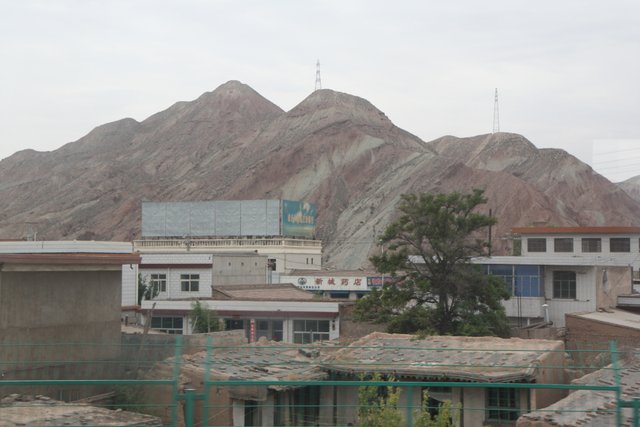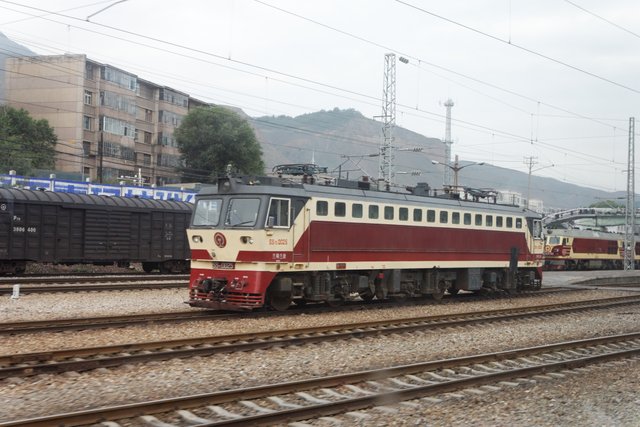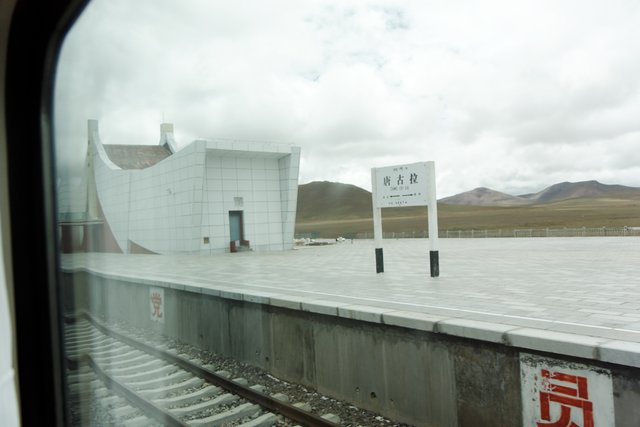34 h train journey from central China to Lhasa, Tibet

A few years ago I made a trip from central Chinese city Xi'an to Lhasa in Tibet.

The 2809 km journey takes 34 hours and covers a large variety of landscapes and amazing scenery. The train starts off in Xi'an at 400 m above sea level, goes up to a maximum of 5072 m then down again to 3656 m when it arrives in Lhasa.

There are four categories of tickets for this train. Hard seat, soft seat, hard sleeper and soft sleeper. As the most luxurious of these tickets was not too expensive (a bit over 100 bucks) I opted for the soft sleeper. As I was travelling alone I was a bit worried that I would not find the right train in the chaotic train station of Xi'an. Therefore I made a practise run the day before and even stood in line at the information desk to ask in my crappy Chinese where the train would leave. It wasn't that difficult in the end to find the right platform because it was labelled in English (the others weren't).

With a soft sleeper ticket you can stay in a room for 4 people. I had to share the room with 4 other people however because a mother shared a bed with her kid. My bed was the lower left one. What cannot be seen is that every bed had an individual TV and an oxygen nozzle in case the thin air on the Tibetan plateau would cause breathing problems.

Shortly after leaving Xi'an the train slowly but steadily climbed up a 1000 m through green mountainous terrain.

Soon after the terrain turned brownish as we were crossing the border of Shaanxi into the Gansu province. Gansu has a semi-arid climate and it's northern part even contains part of the Gobi desert. The train line goes through dry mountainous terrain which I did not find too interesting to take many photos.

After 7.5 hours and 650 km we arrived at the first stop in Gansu's capital city of Lanzhou, a city mainly known for it's pulled noodles. Most people quickly went out to the platform to get some "fresh" air and many of them bought some snacks and instant noodles from ladies selling them on the platform.

Soon after the train continued through brown mountainous terrain towards our next stop in Xining.

Bridge under construction.

One of the many industrial facilites on the way.

Village shortly before Xining.

After three hours the train arrived in Xining, the capital of the Qinghai province. Qinghai is huge (4th largest province) but contains the third smallest population. It is located mostly on the Tibetan plateau.

Xining is a rather nondescript city with bad air and cold climate. It lies at 2275 m above sea level and used to be a hub in a trade corridor along the Northern Silk Road. Nowadays it's main economy are natural ressources and chemicals.

For all of you train fanatics: This is a SS7C, or Type Shaoshan 7C Dual Purpose Electric Locomotive.

Shopping outside of Xining

Soon after Xining the landscape turned green again and a nice rainbow appeared.

Approaching Qinghai Lake it was getting dark and as there was little to do I was going to bed relatively early. The train makes a stop in Golmud a desert city at 2800 m, but I was firmly asleep at that time

When I woke up the train was already in the Qinghai-Tibet Plateau at nearly 3900 m above sea level.

At 6 o'clock in the morning the first snow covered mountains of the Kunlun mountain range appeared.

Although the mountains look like small hills, they reach up to 6000 m.

The next 4 hours the train passed through the Kekexili area (83'000 square km), the worlds third least populated area. However a lot of wild life including rabbits, wild yaks and sheep could be seen all over the place.





The soil slowly turned reddish as we were approaching the Fenghuoshan mountain range. Here the world's highest railway tunnel was built and completed in 2006.

Fenghuoshan (风火山) literally means Wind Fire Mountains (learn these three simple Chinese characters!). According to legend, the Monkey King extinguished the fire raging there using a magic fan which he got from Princess Tieshan.


Display showing the current altitude in meters above sea level. As I was sitting mostly and the acclimatization was slow I did not feel any effect of the low oxygen.


No idea what this was, but it looks like a military convoy.

Later we approached the Tangula Shan Mountain range...

... and shortly after passed Tangula Railway Station at 5068 m. At that point I was amazed that what had seemed like a long journey over even terrain had effectively brought me up from 400 m to over 5000 m. At no point I had the feeling we were going up.

Tangula railway station is at the border between the Qinghai and Tibet province, or better the Tibet autonomous region. It is worth noting that what is commonly described as Tibet or ethno-cultural Tibet also includes autonomous prefectures in neighboring provinces Qinghai, Sichuan and Yunnan.

Lake Cona, the world's highest freshwater lake at 4800 m.

About 4 hours away from Lhasa we made one last stop in Nagqu and this time got some real fresh air, although rather thin one.


Shortly before arriving in Lhasa the train goes along the Nyenchen Tanglha Mountains, a 700 km long mountain range reaching up to 7000 m.

Tibetan petrol station.



Finally after one and a half days the train arrived in Lhasa Railway Station where a lot of family members and tour guides were already expecting the new arrivals. Needless to say that I have not been bored a single minute of this long journey. The ever changing landscape was truely a unique experience and I would repeat it again any time. In one of my next posts I will show some of the impressions of my 5 day stay around Lhasa. See you soon.
Great post! I did this train trip from Beijing to Lhasa, it's really breathtaking on the way.